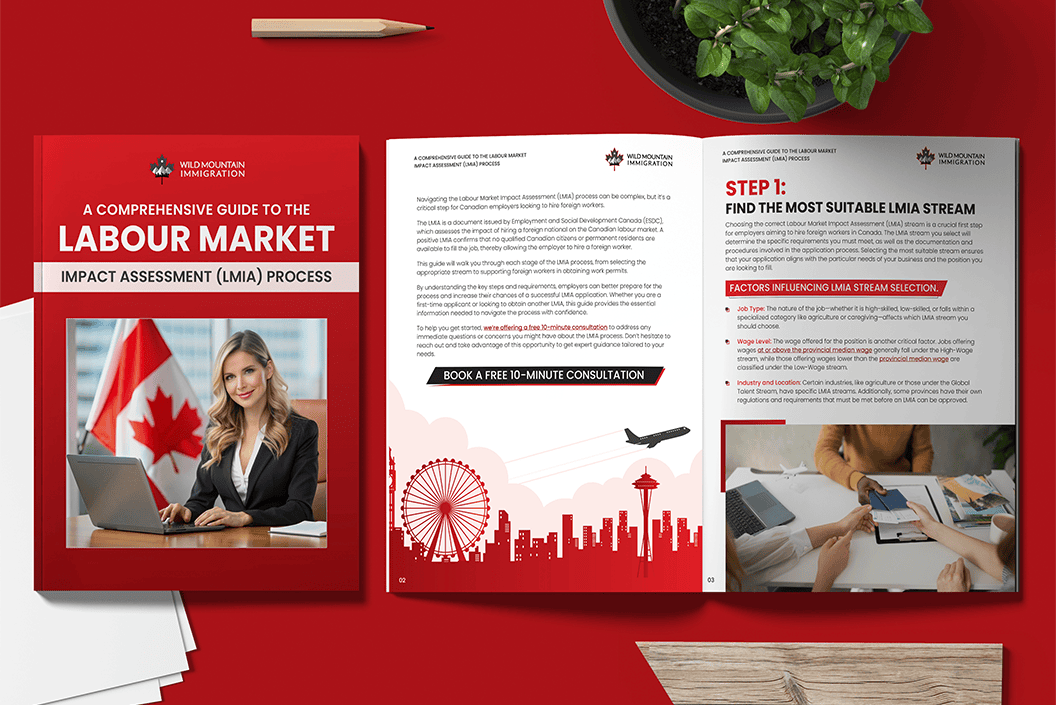Employers in Canada who want to hire foreign workers often need to apply for a Labour Market Impact Assessment (LMIA). A common question is: How many LMIAs can an employer get? The number of LMIAs an employer can obtain depends on several factors, such as wage levels, industry, and regional labour needs. Understanding the LMIA process is crucial for employers who want to meet Canadian labour standards while filling job vacancies.
In this post, we’ll explain the LMIA process, explore the different types of LMIA streams, and clarify how many LMIAs can an employer get in Canada.
What Is an LMIA and Why Do Employers Need It?
An LMIA (Labour Market Impact Assessment) is a document issued by Employment and Social Development Canada (ESDC) that Canadian employers must secure before hiring a foreign worker. The LMIA process assesses whether there are any qualified Canadian citizens or permanent residents available to fill the position. It ensures that hiring a foreign worker will not negatively affect the Canadian labor market, safeguarding opportunities for domestic workers while allowing employers to address skill shortages when necessary.
How Many LMIAs Can an Employer Get?
So, how many LMIAs can an employer get in Canada? The answer depends on several factors, particularly when hiring for low-wage positions. There is no strict limit for high-wage roles, but for low-wage positions, employers must comply with caps that limit the number of foreign workers they can hire in proportion to their workforce.
Key Factors Affecting LMIA Numbers:
- Wage Level: High-wage positions do not have formal caps on the number of LMIAs an employer can get. For low-wage roles, employers must adhere to a cap, usually set at 20% of their workforce. In certain industries, like agriculture or food processing, this cap may rise to 30%.
- Industry Type: Industries with labor shortages, such as agriculture, may allow for a higher percentage of foreign workers, increasing the potential number of LMIAs an employer can get.
- Regional Unemployment Rates: In regions with higher unemployment rates, restrictions may apply to how many LMIAs an employer can receive. This ensures the local labor market is protected.
- Employer Compliance: Employers with a strong compliance record may face fewer challenges when applying for multiple LMIAs, while those with past violations could face more scrutiny.
Need Expert Assistance with LMIA Applications?
Our experienced Canadian immigration consultants simplify the process, helping you obtain the approvals you need to grow your team.
How Many LMIAs Can Employers Get for High-Wage Jobs?
For high-wage jobs, there is no formal cap on the number of LMIAs an employer can obtain. As long as the employer meets the program’s requirements and justifies the need for foreign workers, they can continue to apply for multiple LMIAs. This makes it easier for employers in sectors such as technology, engineering, or healthcare to bring in foreign talent without facing limits on the number of workers they can hire.
How Many LMIAs Can Employers Get for Low-Wage Jobs?
For low-wage positions, employers face more restrictions. Typically, employers are capped at hiring foreign workers for up to 20% of their workforce. However, this cap can be raised to 30% in industries with labor shortages, such as agriculture, hospitality, or food processing. This cap ensures that Canadian companies do not rely too heavily on foreign workers for low-wage roles and continue making efforts to hire local talent.
Types of LMIA-Based Work Permits
Employers may apply for different types of LMIA-based work permits, depending on the job and industry. Each type of LMIA stream can impact how many LMIAs an employer can get.
- High-Wage LMIA Stream The high-wage stream stream applies to skilled or semi-skilled roles where the wage exceeds the provincial median. Employers can apply for multiple LMIAs as long as they meet the program’s requirements.
- Low-Wage LMIA Stream The Low-wage stream is subject to the 20-30% cap on foreign workers in a company's workforce. This stream allows employers to fill labor shortages in lower-wage roles while maintaining a balance by hiring local workers.
- Agricultural LMIA Streams The Agricultural Streams, including the Seasonal Agricultural Worker Program (SAWP) and the general Agricultural Stream, allow Canadian farms to recruit foreign workers to meet essential labor demands. The cap may be raised for employers in this sector.
- Permanent Residence LMIA (Express Entry) Stream This Permanent Resident Stream allows employers to help temporary foreign workers transition to permanent residency by adding points to their Express Entry profile. Employers can retain skilled foreign workers, making this stream attractive for long-term hires.
- Global Talent LMIA Stream The Global Talent Stream is designed for fast-growing industries, such as technology or engineering. It offers fast-track LMIA processing (1-2 weeks) to help companies hire highly skilled foreign professionals quickly.
- In-Home Caregiver LMIA Stream The In-Home Caregiver Stream is for households that need specialized care for children, seniors, or individuals with medical needs can hire foreign caregivers through this stream.

Steps to Apply for an LMIA
To successfully apply for an LMIA, employers must follow several key steps:
- Identify the Correct NOC Code: Classify the job correctly using the National Occupational Classification (NOC) system, as this will determine wage levels and other conditions.
- Advertise the Position: Employers must prove they made genuine efforts to hire Canadians or permanent residents. This usually involves posting the job on the Government of Canada’s Job Bank and other platforms for at least four weeks.
- Submit the LMIA Application: Once recruitment efforts are complete, employers can submit their LMIA application to ESDC, along with proof of recruitment, job offer details, and the required fee.
- Receive the LMIA Decision: ESDC will assess the application and issue a decision. A positive LMIA allows the employer to proceed with hiring a foreign worker.
Employer Responsibilities After Receiving an LMIA
Once an LMIA is approved, employers must:
- Provide the foreign worker with the LMIA approval and job offer.
- Ensure the foreign worker applies for their work permit before the LMIA expires (typically six months).
- Comply with obligations such as providing return airfare, suitable housing, workplace insurance, and ensuring a safe working environment.

Download Your Free LMIA Process Guide
Our guide offers clear, step-by-step instructions to help you avoid common pitfalls and increase your chances of approval.
Challenges and Best Practices for Employers
Employers applying for an LMIA can face several challenges. Here are common pitfalls and best practices to avoid them:
- Mistakes in LMIA Application: Errors like missing information, incorrect NOC classification, or insufficient supporting documents can result in delays or denials.
- Not Meeting Recruitment Requirements: Inadequate recruitment efforts or not advertising for the required duration can lead to LMIA rejection.
- Advertising Mistakes: Failure to follow ESDC’s strict advertising guidelines, such as using incorrect platforms or not providing sufficient job details, can lead to refusal.
Best Practices:
- Ensure job ads meet ESDC guidelines and are posted on multiple platforms.
- Maintain detailed documentation of recruitment efforts.
- Stay informed of wage requirements and local employment laws to avoid issues during the application process.
Conclusion
In summary, how many LMIAs an employer can get depends on several factors, including the wage level, job type, and employer compliance. For high-wage jobs, there is no formal cap, but for low-wage positions, employers must comply with the 20-30% cap. By understanding these rules and following best practices, employers can navigate the LMIA process successfully.
Book Your Free LMIA Consultation
Our experienced Canadian immigration consultants simplify the process, helping you obtain the approvals you need to grow your team.
LMIA FAQs
LMIA approval rates vary but are generally high—between 75% and 95%—for well-prepared applications, particularly in high-demand sectors. Companies that meet all requirements and follow the application process correctly tend to have higher approval chances. Working with an immigration consultant can significantly improve your approval odds by ensuring that the application is accurate, complete, and adheres to all recruitment and compliance guidelines.
An LMIA is typically valid for six months. During this period, the foreign worker must apply for a work permit. If the work permit is not submitted within this time frame, the LMIA will expire, and the employer will need to reapply.
Yes, an LMIA can help lead to permanent residency. Employers can support foreign workers’ applications for PR by providing an LMIA, which adds points to their Express Entry profile and improves their chances of receiving an Invitation to Apply (ITA) for permanent residency.
Recent updates to the LMIA program allow certain industries, like agriculture and food services, to increase the cap on low-wage foreign workers from 20% to 30% of the workforce. Additionally, greater scrutiny is now applied to recruitment efforts to ensure that Canadian citizens and permanent residents are considered first.
The standard fee for an LMIA application is $1,000 CAD per position, although there are some exemptions for certain types of LMIA applications, such as those in the agricultural sector.
Processing times for LMIA applications vary by stream. For example, the Global Talent Stream typically takes 1-2 weeks, while high-wage and low-wage streams take around 2-6 months.
Yes, employers can apply for multiple LMIAs simultaneously, particularly for high-wage roles where there is no cap. However, for low-wage positions, employers must adhere to the 20-30% limit.
Yes, an LMIA can be refused if the employer fails to meet recruitment requirements, doesn’t advertise the position adequately, or submits an incomplete or incorrect application.
Canadian Immigration FAQs
Find quick answers to the most common questions about Canadian immigration, visas, and permanent residency.
LMIA Costs Explained: How Much Does LMIA Cost in 2024?
For Canadian employers seeking to hire foreign workers, a Labour Market…
Can I Leave Canada After Applying for Spousal Sponsorship?
When applying for spousal sponsorship in Canada, many applicants wonder,…
Who Can Apply for BOWP (Bridging Open Work Permit) in Canada?
If you’re transitioning from temporary status to permanent residence in…
Start Your Canadian Immigration Journey
Our experts make the process clear, stress-free, and successful, so you can move forward with confidence and focus on what matters most.

Contact Us
Immigration questions and service enquiries
Consultation
Speak to an expert
immigration consultant
"*" indicates required fields



